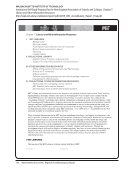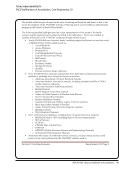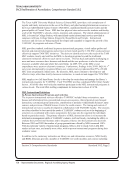28 · Survey Results: Survey Questions and Responses
Unknown at this time. The Middle States team had their final visit April 2–4, 2012. The final report and any
recommendations have not been received, yet.
New England Association of Schools and Colleges – Commission on Institutions of Higher Education (NEASC-CIHE)
2009
New England Association of Schools and Colleges – Commission on Institutions of Higher Education (NEASC-CIHE)
2009
Standard Seven in effect in 2009. Standards were revised in 2011.
“Research, study, and teaching are heavily dependent on rich information resources, especially resources in electronic
form the acquisition of such resources must be sustained as a high priority.” “Further consolidation of libraries, most
notably, the Engineering and Science Libraries...”
North Central Association of Colleges and Schools – Higher Learning Commission (NCA -HLC)
2010
Library evidence for the following institution-wide criteria: Understanding of and support for the mission pervade the
organization. The organization creates effective learning environments. The organization’s learning resources support
student learning and effective teaching. The organization assesses the usefulness of its curricula to students who will
live and work in a global, diverse, and technological society. The organization provides support to ensure that faculty,
students, and staff acquire, discover, and apply knowledge responsibly. The organization learns from the constituencies
it serves and analyzes its capacity to serve their needs and expectations. The organization has the capacity and
the commitment to engage with its identified constituencies and communities. The organization demonstrates its
responsiveness to those constituencies that depend on it for service. Internal and external constituencies value the
services the organization provides.
“University Library: The strategic direction identified and being followed by the university library appears to be a
good one. The challenges facing the redefinition of the modern university library are well articulated in the self-study.
Consciousness of these challenges will help the institution to engage in conversations with others that will help achieve
the vision of recreating the library as an intellectual commons for the university community. This consciousness has
practical value: by articulating these goals, institutional leaders will be better able to identify university development
activities that contribute to the library’s needs – for example, “friends of the library” drives may focus on particular
initiatives, or the library could develop partnerships with learning communities and teaching efforts (e.g., as a satellite
location for tutoring programs). The libraries might look also to extending services to the broader community, by
extending the principle of the intellectual commons to the community.”
North Central Association of Colleges and Schools – Higher Learning Commission (NCA -HLC)
2010
Strategic plan. List of library faculty committees committee reports/minutes for previous year. Current and potential
collaborations between library and other campus units. Library faculty professional development data: name of
Unknown at this time. The Middle States team had their final visit April 2–4, 2012. The final report and any
recommendations have not been received, yet.
New England Association of Schools and Colleges – Commission on Institutions of Higher Education (NEASC-CIHE)
2009
New England Association of Schools and Colleges – Commission on Institutions of Higher Education (NEASC-CIHE)
2009
Standard Seven in effect in 2009. Standards were revised in 2011.
“Research, study, and teaching are heavily dependent on rich information resources, especially resources in electronic
form the acquisition of such resources must be sustained as a high priority.” “Further consolidation of libraries, most
notably, the Engineering and Science Libraries...”
North Central Association of Colleges and Schools – Higher Learning Commission (NCA -HLC)
2010
Library evidence for the following institution-wide criteria: Understanding of and support for the mission pervade the
organization. The organization creates effective learning environments. The organization’s learning resources support
student learning and effective teaching. The organization assesses the usefulness of its curricula to students who will
live and work in a global, diverse, and technological society. The organization provides support to ensure that faculty,
students, and staff acquire, discover, and apply knowledge responsibly. The organization learns from the constituencies
it serves and analyzes its capacity to serve their needs and expectations. The organization has the capacity and
the commitment to engage with its identified constituencies and communities. The organization demonstrates its
responsiveness to those constituencies that depend on it for service. Internal and external constituencies value the
services the organization provides.
“University Library: The strategic direction identified and being followed by the university library appears to be a
good one. The challenges facing the redefinition of the modern university library are well articulated in the self-study.
Consciousness of these challenges will help the institution to engage in conversations with others that will help achieve
the vision of recreating the library as an intellectual commons for the university community. This consciousness has
practical value: by articulating these goals, institutional leaders will be better able to identify university development
activities that contribute to the library’s needs – for example, “friends of the library” drives may focus on particular
initiatives, or the library could develop partnerships with learning communities and teaching efforts (e.g., as a satellite
location for tutoring programs). The libraries might look also to extending services to the broader community, by
extending the principle of the intellectual commons to the community.”
North Central Association of Colleges and Schools – Higher Learning Commission (NCA -HLC)
2010
Strategic plan. List of library faculty committees committee reports/minutes for previous year. Current and potential
collaborations between library and other campus units. Library faculty professional development data: name of
























































































































































































